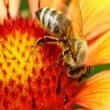Background
- Bee pollen is considered a highly nutritious food because it contains a balance of vitamins, minerals, proteins, carbohydrates, fats, enzymes, and essential amino acids. Pollen comes from various plants, including buckwheat, maize, pine (songhaufen), rape, and typha (puhuang). Avoid confusion with bee venom, honey, and royal jelly. Bees use propolis, a resinous substance, to construct their hives while royal jelly is secreted from the salivary glands of bees.
- The lay public probably uses it more often than is prescribed in clinical practice. Typically, bee pollen is used as a rejuvenator or a tonic. It is also used to enhance athletic stamina and strength and to assist in recovery from illness. Bee pollen is often used as a pollen and spore antidote during allergy season. It may aid in respiratory complaints such as bronchitis, sinus congestion, and common rhinitis. In the support of hormonal disorders, bee pollen is thought to balance the endocrine system with specific benefits in menstrual and prostate disorders. In Chinese medicine, bee pollen is used for building blood, reducing cravings for sweets and alcohol, as a radiation protectant, and a cancer inhibitor. Topically it is used for eczema, skin eruptions, and diaper rash. Available research does not adequately support its use for these indications.
References
- Aliyazicioglu Y, Deger O, Ovali E, et al. Effects of Turkish pollen and propolis extracts on respiratory burst for K-562 cell lines. Int Immunopharmacol 2005;5(11):1652-1657.
View Abstract - Boppre M, Colegate SM, Edgar JA. Pyrrolizidine alkaloids of Echium vulgare honey found in pure pollen. J Agric Food Chem 2005;53(3):594-600.
View Abstract - Campos MG, Webby RF, Markham KR, et al. Age-induced diminution of free radical scavenging capacity in bee pollens and the contribution of constituent flavonoids. J Agric Food Chem 2003;51(3):742-745.
View Abstract - Garcia-Villanova RJ, Cordon C, Gonzalez Paramas AM, et al. Simultaneous immunoaffinity column cleanup and HPLC analysis of aflatoxins and ochratoxin A in Spanish bee pollen. J Agric Food Chem 2004;52(24):7235-7239.
View Abstract - Gonzalez G, Hinojo MJ, Mateo R, et al. Occurrence of mycotoxin producing fungi in bee pollen. Int J Food Microbiol 2005;105(1):1-9.
View Abstract - Greenberger PA, Flais MJ. Bee pollen-induced anaphylactic reaction in an unknowingly sensitized subject. Ann Allergy Asthma Immunol 2001;86(2):239-242.
View Abstract - Iarosh AA, Macheret EL, Iarosh AA, et al. [Changes in the immunological reactivity of patients with disseminated sclerosis treated by prednisolone and the preparation Proper-Myl]. Vrach Delo 1990;(2):83-86.
View Abstract - Iversen T, Fiirgaard KM, Schriver P, et al. The effect of NaO Li Su on memory functions and blood chemistry in elderly people. J Ethnopharmacol 1997;56(2):109-116.
View Abstract - Krivopalov-Moscvin I. Apitherapy in the rehabilitation of patients with multiple sclerosis -- XVI World Congress of Neurology. Buenos Aires, Argentina, September 14-19, 1997. Abstracts. J Neurol Sci 1997;150 Suppl:S264-367.
View Abstract - Lei H, Shi Q, Ge F, et al. [Supercritical CO2 extraction of fatty oils from bee pollen and its GC-MS analysis]. Zhong Yao Cai 2004;27(3):177-180.
View Abstract - Medina A, Gonzalez G, Saez JM, et al. Bee pollen, a substrate that stimulates ochratoxin A production by Aspergillus ochraceus Wilh. Syst Appl Microbiol 2004;27(2):261-267.
View Abstract - Ozcan M, Unver A, Ceylan DA, et al. Inhibitory effect of pollen and propolis extracts. Nahrung 2004;48(3):188-194.
View Abstract - Palanisamy A, Haller C, Olson KR. Photosensitivity reaction in a woman using an herbal supplement containing ginseng, goldenseal, and bee pollen. J Toxicol Clin Toxicol 2003;41(6):865-867.
View Abstract - Paola-Naranjo RD, Sanchez-Sanchez J, Gonzalez-Paramas AM, et al. Liquid chromatographic-mass spectrometric analysis of anthocyanin composition of dark blue bee pollen from Echium plantagineum. J Chromatogr A 2004;1054(1-2):205-210.
View Abstract - Wang J, Jin GM, Zheng YM, et al. [Effect of bee pollen on development of immune organ of animal]. Zhongguo Zhong Yao Za Zhi 2005;30(19):1532-1536.
View Abstract







